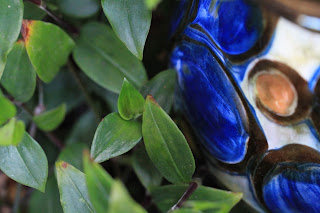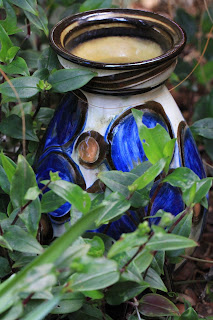Left: Kähler Vase and Wandering Jew; Right: Detail of Vase and Leaves
In this POTS and PLANTS episode we pair a Kähler Keramik vase and Tradescantia fluminensis – commonly known as a Wandering Jew (which I’ve always found to be a curious name). Tradescantia is a member of the Commelinaceae family also referred to as the dayflower or spiderwort family.
The Kähler and Colchicum post contains history about Kähler Pottery. When I first saw this vase I thought it looked gaudy. After a while, it grew on me. I believe the design was created with a process called horn painting, literally a cow horn filled with slip and used like a pen to draw on the piece. On the bottom of the vase a “HAK” mark is incised. I don’t know the date of the piece. The vase is 8 inches tall.
The Kähler vase is placed in a patch of Tradescantia that survives year round outside. It’s protected with an overhang and is right on the foundation – both factors likely responsible for it survival. Tradescantia can be very invasive (see for example, this New Zealand pest information sheet – where it is called equally curiously Wandering Willy), but here in our Seattle yard, it isn’t a pest.
Quattrocchi says of the generic name’s origin:
“For the British (b. Meopham, Kent) naturalist and botanist John Tradescant, 1608 – 1662 (d. South Lambeth, Surrey), traveler, plant collector in Virginia, from 1638 gardener to Queen Henrietta Maria (Keeper of His Majesty’s Garden of Oatlands) author of Musaeum Tradescantianum. London 1656, and for his father John Tradescant, circa 1570/1575 – 1638 (d. South Lambeth, Surrey) traveler and botanical collector, friend of John Parkinson (1567 – 1650), gardener to Robert Cecil (Earl of Salisbury) and to Sir Wotton, 1618 went to Russia (the first western European botanist), 1630 Keeper of His Majesty’s Gardens at Oatlands”
The specific epithet fluminensis means of or from Flumen Januarii (Rio de Janeiro, Brazil) [Dave’s Garden Botanary]. This plant is native to South America and was catalogued by José Mariano de Conceição Vellozo a Brazilian botanist. In his main work Florae Fluminensis (1825-27, 1831) the entry for this species is:
“Vaginae florium pilosae; stamina antheris binis ad apicem; flamentis pilosis e basi e medium. Habitat maritimis ad rivulorum ripas, locaque humentia.” [From an 1881 publication of the work at Botanicus]
Which Google Translate gives (as an approximation to the original intent):
Flowers sheaths hairy anthers two threads to the apex; flamentis hairy from the base of the second half. Inhabits coastal streams to the banks, and the adjoining wet.
From the Tradescants in England to Vellozo in Rio de Janeiro to Kähler in Denmark to our yard in Seattle. Quite a jaunt to talk about a pot and a plant?
Left: Top of Kähler Vase; Right: Kähler Vase in the Wild
Left: Kähler Vase Hiding with Wandering Jew; Right: Bottom Incised HAK
Excerpt from Florae Fluminensis for Tradescantia fluminenis





No comments:
Post a Comment
All comments are moderated. If your comment doesn't appear right away, it was likely accepted. Check back in a day if you asked a question.